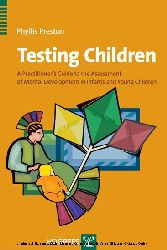Suchen und Finden
Mehr zum Inhalt

Testing Children: A Practitioner's Guide to Assessment of Mental Development in Infants and Young Children
Table of Contents
8
Introduction
12
1 The Challenge of Evaluation
16
Making Sense of Information
16
A Brief History of Mental Measurement
17
What Test Scores Do not Measure
19
Points for Reflection
21
2 The Concept of Mind
22
An Evolutionary View
22
The Mental Legacy
23
Soul, Mind and Thought
23
Body and Mind
24
3 The Psychological Route
26
Issues in Communication
26
Two Different Faces of Psychology
27
Gateways to the Mental Domain
28
Underlying Processes in the Mental Domain
33
The Structure of Thinking (see also Appendix 1)
34
4 About Numerical Values of Mental Ability
40
The Meaning of Numbers
40
Norm-Referenced Testing
41
What Do We Need to Know?
42
The Concept of Mental Age
44
Understanding the Nature of Psychometric Tests
44
More About the Process of Test Development
47
IQ in Relation to the Normal Distribution Curve
49
Some important points to bear in mind
50
Why the Need for Precision?
51
5 About Individual Tests of Mental Development
54
Introduction
54
Test Content
54
Structure
59
Packaging
60
Section Three: Issues in Application
62
6 Common Errors During the Assessment Interview
64
Introduction
64
The Assessment Setting
65
The Social Skills of Engagement
66
Parental Preparation
68
Test Administration
69
Scoring
73
The Care of Test Materials
76
Some Practical Suggestions for Maintaining the Flow of the Test Session
77
7 The Task of Observation
80
Introduction
80
Issues in Observation
80
How to Improve Observation Skills
82
8 How Skilled Observation Assists Evaluation
84
Introduction
84
The Area of Vision (see also Appendix 6 and 8)
86
The Area of Touch (see Appendix 7 on the hands)
88
9 Facilitators and Promoters in the Developmental Process
90
Introduction
90
The Child with Emergent Skills
90
The Child as a Whole
96
The Quality of Parenting
98
10 Communicating Findings: How to Write a Report
100
Introduction
100
The Contents of the Report
101
11 Some Memorable Moments During Assessments
106
Introduction
106
Motherly Love
106
Shaken and Stirred
107
Finally Satisfied
108
Epilogue Beyond the Finishing Line: A Wide Angle Glance
110
Appendices and References
116
Appendix 1: How We Make Sense of Information Received: A Possible Model for the Structure of Thinking
118
Appendix 2: Nature and Function of Measurement
121
Appendix 3: The Gaussian Curve and Equivalent Values
126
Appendix 4: Table of IQ Ranges and their SD Points and Descriptive Levels
127
Appendix 5: Notes on Play
128
Appendix 6: Language Development
130
Appendix 7: The Hand (Notes derived from the book “Touching for Knowing” by Hatwell, Streri, & Gentaz, 2003)
134
Appendix 8: Facial Expressions
140
Alle Preise verstehen sich inklusive der gesetzlichen MwSt.








